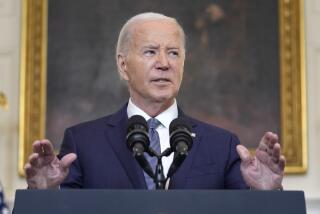U.S. to Carefully Weigh New Soviet Arms Offer : Details of Kremlin Proposal Are Withheld but Reagan Reiterates Intention to Drop SALT II
WASHINGTON â The Soviet Union made a new offer at the Geneva arms control talks Wednesday to cut long-range nuclear weapons and President Reagan promised at a press conference to give it serious study.
But at the same time, Reagan said he still will follow his recently announced policy of abandoning the second strategic arms limitation agreement later this year unless the Soviets improve their record of complying with it.
One reliable source characterized the new Soviet offer as âa major step . . . which will put additional pressure on the Administration to remain within the SALT II agreement.â However, he declined to provide details of the proposal, presented in a special plenary session of the continuing arms control negotiations in Geneva.
âRoom for Optimismâ
Sen. Ted Stevens (R-Alaska), who as co-chairman of the delegation of congressional observers to the talks was briefed by a U.S. diplomat on the latest Soviet move, said: âThere is room for optimism. There is movement in Geneva. Thatâs good news to the world.â
Because of the âconfidentiality of the situation,â Reagan told the nationally televised press conference, he could not comment further on the new Soviet proposal.
Elsewhere in his press conference, Reagan:
--Said that âso far thereâs been no evidence presented to us from anyoneâ to back up charges that the Israeli government is managing a wide-ranging espionage network in the United States.
--Expressed his personal support for building a fourth space shuttle to replace the lost Challenger but said that no final decision has been made.
--Said he found it difficult âto find any cases of starvationâ or under-nourishment in the United States.
The latest Soviet arms offer represents an elaboration of a proposal by Moscow two days after the Reagan announcement in May that the SALT II pact would be abandoned, according to congressional sources. The Soviets suggested 50% cuts in the offensive strategic weapons of both sides if the United States agreed to extend by 10 to 20 years the 1972 Anti-Ballistic Missile Treaty. Either side now may pull out of the ABM pact on six monthsâ notice.
Such an extension would bar deployment of the Administrationâs space-based anti-missile defense, widely known as âStar Wars,â for that period. But it would permit research on directed energy weapons, including laser beams, in space.
The Soviets also picked up the Administration proposal to open the weapons laboratories of each nation to visits by scientists from the other side as a way to help monitor such an agreement.
Unratified but Practiced
Even though the U.S. Senate never ratified the 1979 treaty, which limited each sideâs missiles and bombers, the United States has remained within the treatyâs limits for more than seven years. But on May 27, Reagan announced an end to that policy unless the Soviets end alleged cheating on the agreement, moderate their arms buildup and promote progress at the Geneva arms talks.
Specifically, Reagan said that the Administration is planning to exceed the treatyâs limits later this year by converting more B-52 bombers to carry air-launched cruise missiles than the treaty would permit.
Reagan left open the possibility--both in his original announcement and in his Wednesday news session--that the United States would stay within the accordâs limits if the Soviets stop violating the treaty.
Pressed as to whether he intends to abandon the treaty, Reagan declared:
âWe have a plane coming up to be armed with a cruise missile (in fact, 14 per plane) that would put us to that extent beyond the constraints or the limitations. Now we have several months before we reach that point. . . . Weâre going to see if we can persuade them to join in the things they are talking about--arms reduction--and if nothing is done, then we will make the decisions with regard to that plane.â
The agreement, Reagan said, âdidnât do anything to reduce nuclear weapons or the nuclear threat. All it did was regulate how fast and how much we could continue increasing the number of weapons.â
Gorbachev Remarks
The President said he wants to see the unratified 1979 arms pact replaced âwith a realistic program of arms reduction, which has been my goal ever since Iâve been here.â And in Soviet leader Mikhail S. Gorbachev, he said, the Soviets for the first time have a leader who has âvoluntarily spoken of reducing nuclear weapons and we want to follow up on that.â
Reagan reiterated his conviction that he and Gorbachev would meet again in coming months, after their introductory session last November. âI still believe that he wants a summit, and I want a summit and I believe itâs going to take place,â he said. But he would not predict when it would occur.
The present round of Geneva talks, which began in January, 1985, shortly before Gorbachevâs rise to power, consist of three separate negotiating arenas: one on long-range nuclear weapons, one on intermediate-range nuclear missiles and one on missile defenses in space. Up to now, the two sides have agreed in principle to aim for a 50% cut in offensive strategic weapons. But that masks fundamental disagreement over which weapons to cut.
The Soviets, for example, want the equation to include U.S. shorter-range bombers in Europe but not its own weapons of that range because they cannot reach the United States.
Limits on Warheads
And while both sides want to limit warheads on missiles and they disagree over some sub-limits, Washington would put lower limits on land-based intercontinental ballistic missile warheads, the strongest feature of the Soviet arsenal, and ban mobile missiles, which Moscow is now deploying. The Soviets would ban all cruise missiles with a range of more than 375 miles, a weapon in which the United States enjoys a great advantage in numbers and sophistication.
In the negotiations on space weapons, the Soviets initially wanted to ban all research on space defense weapons, which they call âspace strike arms,â and refused to discuss their relationship to offensive weapons. But in their May 29 proposal, they offered to permit research on space-based defensive weapons to continue.
And in the talks on intermediate-range weapons, both sides have agreed to aim for the elimination of nuclear missiles from Europe. But the United States also wants âproportionateâ reductions of mobile Soviet SS-20 missiles in Asia, while the Soviets would merely freeze the number of such weapons now in Asia. The Soviets also want British and French missiles frozen at existing levels.
Sen. Stevens said he is not familiar with details of the newest Soviet offer. However, he called it the âthird installmentâ by the Soviets at the arms negotiations, after the May 29 offer and the proposal of last fall in which the Soviets unveiled its 50% cut in offensive arms.
âSame as Beforeâ
Stevens contended that the offer was evidence that the Soviets--like Reagan--have decided to turn their attention away from adherence to the SALT II agreement and begin to search for an agreement on reductions of nuclear weapons.
âI believe that the Soviets, whether they articulate it or not, have done the same thing as we have done, and that is to move beyond SALT II,â he said. âIâm informed that this latest addition in Geneva today is consistent with my interpretation.
âItâs a tacit acknowledgement that SALT II is an agreement of the past. It continues a trend toward articulating a future relationship rather than disputing the numbers as we have done in the past.â
Stevens said the offer ought to halt the debate in Congress over whether the United States should continue to comply with treaty.
âAnyone who takes steps now that could undercut our negotiations in Geneva is making a mistake,â he said, referring to other members who have offered legislation that would force Reagan to comply with SALT II. âI hope it does cool off some of these people.â
Congressional Opposition
The Democratic-controlled House is expected to pass a non-binding resolution as early as next week that would call upon Reagan to abide by the treaty. The GOP-dominated Senate is likely to follow suit with a similar measure co-sponsored by Republicans as well as Democrats.
In a meeting with a few Republican and Democratic senators Wednesday, White House national security adviser John M. Poindexter indicated that the Presidentâs opposition to continued SALT II compliance could not be altered by non-binding legislation. âHe didnât exhibit very much distress,â Sen. John Heinz (R-Pa.) said after the meeting.
If Reagan refuses to back down in the face of non-binding legislation, members of both the House and Senate have vowed to press binding measures that would write the treaty limits into U.S. law. Sen. Joseph R. Biden Jr. (D-Del.), co-author of one such measures, said he hopes that they will not be forced to vote on it.
Biden declared that Reaganâs arms control policy is being influenced by âright-wingâ advisers who are bent on destroying SALT II and âthe whole strategic frameworkâ of arms control. âWe face the functional equivalent of a national emergency in the conduct of our strategic policy,â Biden declared.
Times staff writer Sara Fritz contributed to this story.
More to Read
Sign up for Essential California
The most important California stories and recommendations in your inbox every morning.
You may occasionally receive promotional content from the Los Angeles Times.










